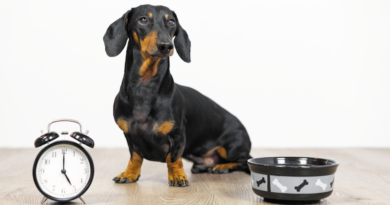My 7 Tips After Years of Struggle
[ad_1]
Getting a good night’s sleep is important for your dog’s health, and having a sleep routine and schedule helps dogs in other ways as well. Such a predictable routine gives a dog a sense of security, and it will make your life easier, too. Knowing how to make a dog sleep is a skill that many pet owners, especially puppy owners, will find very useful.
Dogs generally sleep more than humans, and most of the time they’re happy to sleep when we go to bed for the night. If your pet keeps you awake pacing and playing all night long, you might need to make some changes to the dog’s overall daily life. Small differences in their diet, daily environment and regular routine can improve your dog’s sleep.
How Much Should My Dog Sleep?
Dogs will sleep anywhere from 12 to 18 hours per day. This is normal. But, how much your dog sleeps will depend on a large number of variables.
Older dogs will sleep more, as they tend to tire out easily with the medical conditions that come with old age, like arthritis and diabetes. Puppies, like newborn babies, need more sleep. They do not have large reserves of energy but they use a lot of it when exploring their surroundings and all the energy they use to grow.
A dog’s health condition is very important to consider no matter what his age. Disorders such as epilepsy will have a big impact on how much your dog sleeps. It’s also possible for dogs to have chronic sleep disorders, like narcolepsy, that would impact how many hours a day he would sleep.
A dog’s breed is also a factor in how much sleep he requires. There are a number of lazy dog breeds that are well-known for sleeping all day. There’s a correlation in size, and it’s been observed that larger breeds do tend to sleep a little more than small dogs.
Their health condition and hormone balance will impact sleeping behavior too. For example, bored, depressed and apathetic canines are likely to sleep more. Even seasons can impact your dog’s sleeping habits. Dogs sleep more in winter due to lack of sunlight and increased production of melatonin.
RELATED: How To Get Your Dog To Sleep On A Dog Bed
7 Tips on How to Make a Dog Sleep at Night
1. Create a Routine
All dogs need a routine. If their schedule is sporadic, they can’t get used to anything. They’ll never know what is coming next, and that means they won’t be able to figure out what they are supposed to be doing.
The dog will need a specific daily routine for:
- Walks
- Exercise/Playtime
- Feeding
- Naps
- Bedtime
Your pooch should be taking naps only in the morning and afternoon. You don’t want him to take any naps within 2 hours of bedtime. If the dog sleeps before bed, he won’t be tired when he lies down for the night, defeating the whole point.
You should also feed your pet 3-4 hours before bedtime. That will allow for plenty of time to use the bathroom before climbing into bed for the night. If your dog is energetic, set aside some time to play about 1-1.5 hours before bed.
2. Exercise
I mentioned squeezing in some play time before bed, but it’s important that your dog gets to burn all of his mental and physical energy during the day. If not, he may wake up feeling rested in the middle of the night.
Do you go to work for most of the day? That’s okay. You can leave puzzle toys to entertain your dog during the day. You can also check in and play with your pooch during the day using a pet camera.
Make sure to get your pup outside for playtime when you can. Check out your local dog park, go for a long walk or visit some dog-friendly establishments in your community. Try not to do the same things every day. The more variety in your dog’s life, the more mentally stimulating it will be.
3. Promote Relaxation
Can you sleep when your mind is racing? What if you’re all worked up due to some dramatic event? If you’re expecting your dog to fall asleep, you need to make sure that he’s relaxed, calm, not anxious and not stressed. You need to ease him into bedtime.
Once you’ve gotten out all of the dog’s excess energy, have some quiet time about 30 minutes before bedtime. You can relax, snuggle or just lounge around before it’s time to sleep. This will give Fido time to wind down before he needs to settle in for the night.
4. Try Calming Music
There are certain types of music that have been proven to be effective for calming dogs. A new study published in the journal of Physiology and Behavior concluded that the two genres that calm canines the most are reggae and soft rock. Classical music was also mentioned among certain dog sleep studies.
If you can sleep with quiet music playing, it may help to have some on as background noise overnight. The music can help prevent your dog from feeling all alone, and the soothing sounds of the music will help the dog rest peacefully.
Alternatively, you could also use a white noise machine. I’ve previously done a podcast on this very subject if you’re curious to learn more about uses of white machines and other similar devices to create ambient for making a dog sleep at night.
Some of the best white noise machines for dogs that I like are:
5. Give the Dog a Bed
You may not mind your dog sleeping in bed with you, but it’s not ideal for either one of you. It’s not a requirement to provide your dog with a pet bed, but there are benefits for both of you. A bed gives your dog a space that is all his own and is likely to encourage going to sleep at night.
A cushion between your pet and the ground also helps to soften the pressure on a dog’s limbs and ease any arthritic pain that he may have in case he normally sleeps on the floor. Your dog will be more comfortable in a dog bed of his own, and you’ll probably sleep better too. You won’t wake up when Fido moves around and vice versa.
6. Chew Toys
Licking and chewing are soothing to dogs. When a dog is stressed or overstimulated mentally, they release their anxiety and energy by chewing and destroying things. For dogs that are always full of energy to go to sleep at night, this could be key.
If you provide your pet with a variety of chew toys or a licking toy coated in peanut butter before bed, it could help soothe and relax him. Not every dog is into chewing, especially before going to sleep at night, but licking toys should entice even the pickiest pups.
7. Supplements
If all else fails, there are a number of natural sleep aids that are safe and effective for dogs. Melatonin is the most common sleep aid used for dogs who won’t go to sleep at night. This should be used only as a last resort and it’s best to have a discussion with your veterinarian before using an over-the-counter sleep supplement for your pet.
Some of the most popular melatonin for dogs supplements to make them sleep are:
Melatonin for dogs is safe and used often, but it needs to be given at very precise dosage based on the dog’s age, size, health condition and as recommended by a veterinarian. Do not give melatonin to pregnant or nursing dogs to make them sleep, and do not feed it to puppies under 12 weeks of age.
As a rule of thumb, melatonin is given to dogs using the below approximate dosage:
- Dog under 10 lbs: 1 mg melatonin
- Dog of 10-25 lbs: 1.5 mg melatonin
- Dog of 26-100 lbs: 3 mg melatonin
- Dog over 100 lbs: 3-6 mg melatonin
It’s best to use melatonin made for pets and for humans. These usually come either as melatonin-only supplements or as calming sleep aid for dogs supplements that contain melatonin among other ingredients. Melatonin made for people may contain xylitol, which is toxic to dogs.
[ad_2]
Source link





